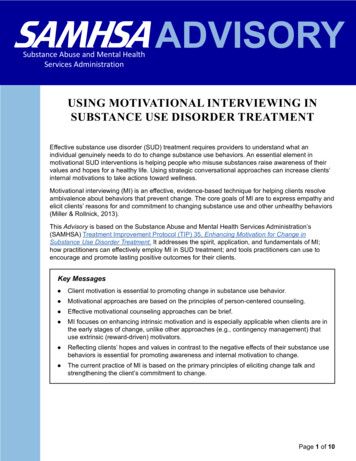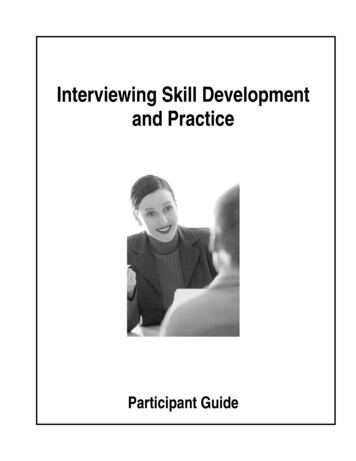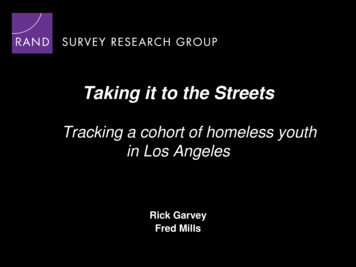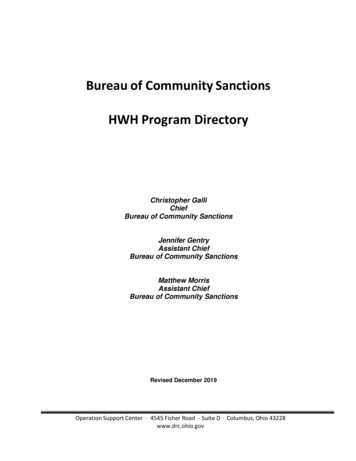
Transcription
MotivationalInterviewingwithAdolescents2015
Objectives Tounderstand the fundamental spirit andprinciples of MI To strengthen empathetic counseling skills(OARS) To understand the directive aspects of MI To experience and practice an MI style forresolving ambivalence To recognize and effectively respond toclient change talk
DefinitionVideo
Beginning Definition“MotivationalInterviewing isa collaborative conversationstyle for strengthening apersons own motivation andcommitment to change.”Miller and Rollnick (2013), “Motivational Interviewing Third Edition”, Guilford Press.
Continuum of StylesDirectingGuidingFollowingMiller and Rollnick (2013), “Motivational Interviewing Third Edition”, Guilford Press.
Developmental Characteristics inAdolescence Biological Cognitive IdentityFormation Autonomy Emergence Family and Peer Relationships
The Spirit passionEvocation
Partnership MIis done “for” and “with” a person not“to” and “on.” An active collaboration between experts MI is not a way of tricking people. There is a profound respect for the other. Seeing the other person’s world viewMiller and Rollnick (2013), “Motivational Interviewing Third Edition”, Guilford Press.
Acceptance-Four Aspects AbsoluteWorth Accurate Empathy Autonomy Support AffirmationMiller and Rollnick (2013), “Motivational Interviewing Third Edition”, Guilford Press.
Compassion“To be compassionate is to actively supportthe other’s welfare, to give priority to theother’s needs.”Miller and Rollnick (2013), “Motivational Interviewing Third Edition”, Guilford Press.
EvocationPeople have what is needed withinthemselves. Our task is to evoke it, to call itforward.People who are ambivalent about changealready have both arguments within them.Miller and Rollnick (2013), “Motivational Interviewing Third Edition”, Guilford Press.
Developmental ProcessThe set of mind and heart necessary for MIdevelops with practice and intent.Practicing MI over time teaches spirit.Miller and Rollnick (2013), “Motivational Interviewing Third Edition”, Guilford Press.
Core Skills Asking Open-endedQuestionsAffirmingReflective ListeningSummarizingInforming and Advising
Open-ended Questions Invitereflection and collaboration Understand internal frame of reference Strengthens collaboration Helps to find a clear direction“Open questions also play a key role inevoking motivation and planning a coursetoward change.”Miller and Rollnick (2013), “Motivational Interviewing Third Edition”, Guilford Press.
Open or Closed Questions Open-Ended Question StemsTell me, Explain, Describe, When, Why Closed Question StemsDid, Are, Is, Where, Can, Have, WillMiller and Rollnick (2013), “Motivational Interviewing Third Edition”, Guilford Press.
Affirming Honorsthe client’s worth and capacity forchange and growth Recognize strengths, abilities and goodintentions Reframe/accentuate the positiveMiller and Rollnick (2013), “Motivational Interviewing Third Edition”, Guilford Press.
Reflective Listening Fundamentalskill in MI Allow people to hear again thoughts andfeelings Keeps people talking Choose what to reflect Deepen understandingMiller and Rollnick (2013), “Motivational Interviewing Third Edition”, Guilford Press.
Summarizing Aselection of reflections presentedtogether strategically Increased understanding Opportunity to fill in what was missed. Used to transition form one task toanother“The process of reflecting is itself affirming.”Miller and Rollnick (2013), “Motivational Interviewing Third Edition”, Guilford Press.
Summary Set up statement: “Let me see if I have this right ” Reflection, reflection, reflection Open question:“So where does thatleave us? What elsewould you like to add?”or “Now, tell me about .”(to re-direct)
Informing and AdvisingThere are times when it is appropriate toprovide information and advice. Askwhat they already know Offer with permission Offer an array of options Help client to reach their own conclusionsabout the relevance of the informationMiller and Rollnick (2013), “Motivational Interviewing Third Edition”, Guilford Press.
What MI is Not Justa way of being nice A solution to all clinical problems A technique, trick or gimmick A way of manipulating peopleMiller and Rollnick (2013), “Motivational Interviewing Third Edition”, Guilford Press.
FourProcessesEngagingFocusingEvokingPlanning
Engaging“Therapeutic engagement is a prerequisitefor everything that follows.” Beginsat the initial visit – no timeframe Process by which both parties establish ahelpful connectionMiller and Rollnick (2013), “Motivational Interviewing Third Edition”, Guilford Press.
Focusing“Focusing is the process by which youdevelop and maintain a specific directionin the conversation.” Clarifydirection Treatment may be the only avenuetoward changeMiller and Rollnick (2013), “Motivational Interviewing Third Edition”, Guilford Press.
Evoking“Evoking involves eliciting the clients ownmotivation for change ” Theperson voices the arguments forchange. People talk themselves into changing. Harness the client’s own feelings andideas regarding the “why” and “how” ofchangeMiller and Rollnick (2013), “Motivational Interviewing Third Edition”, Guilford Press.
Planning Developcommitment and formulate aplan. May need to revisit often and the planunfolds. Elicit clients own solutions – promoteautonomy. Once a decision is reached some peoplemay need little assistance with planning.Miller and Rollnick (2013), “Motivational Interviewing Third Edition”, Guilford Press.
Four ProcessesPlanningElicitingEvokingEngagingMiller and Rollnick (2013), “Motivational Interviewing Third Edition”, Guilford Press.
Summary
A Closer LookEngaging
Engaging and Disengaging“Engaging is the process of establishing amutually trusting and respectfulrelationship.”Miller and Rollnick (2013), “Motivational Interviewing Third Edition”, Guilford Press.
Thomas Gordon’s 12 Roadblocks1)2)3)4)5)6)Ordering, directingWarning, threateningGiving advice, makingsuggestions, providing solutionsPersuading with logic, arguing,lecturingMoralizing, preachingJudging, criticizing, blaming
Thomas Gordon’s 12 Roadblocks(cont.)7)8)9)10)11)12)Agreeing, approving, praisingShaming, ridiculing, name-callingInterpreting, analyzingReasoning, sympathizingQuestioning, probingWithdrawing, distracting,humoring, changing the subject
Traps to Avoido The Assessment Trap/QuestionAnswer Trapo The Expert Trapo The Premature Focus Trapo The Labeling Trapo The Blaming Trapo The Chat TrapMiller and Rollnick (2013), “Motivational Interviewing Third Edition”, Guilford Press.
What Promotes Engagement? Desiresand Goals Importance Positivity Expectations HopeMiller and Rollnick (2013), “Motivational Interviewing Third Edition”, Guilford Press.
Listening Non-verbalListening Reflections (Accurate Empathy) Simple Complex Overshootingand undershootingMiller and Rollnick (2013), “Motivational Interviewing Third Edition”, Guilford Press.
Thinking ReflectivelyModel from Thomas GordonParent Effectiveness trainingWords the Speaker Says2Words the Listener Hears31What the Speaker Means4What the Listener Thinksthe Speaker MeansMiller and Rollnick (2013), “Motivational Interviewing Third Edition”, Guilford Press.
Forming Reflections A hypothesis (guess) about speaker’smeaningA statement to convey understandingIntonation down or flatShort stems “So ”“Sounds like ”“So you ”“Seems like ”“Its like ”“You feel ”
Levels of Reflections Repeating Rephrasing Paraphrasing Reflectionof feelingMiller and Rollnick (2013), “Motivational Interviewing Third Edition”, Guilford Press.
Recognizing MI SkillsIntroduction to CodingVideoReflectionAffirmationSummaryOpen questionClosed Question
Exploring Goals and Values Noone is unmotivated Exploring life goals has a way helpingpeople see the horizon “Drug dependence has a way orforeshortening time perspective.” Important source of motivation to change Not uncommon for day-to-day behaviorto conflict with long-term live goals andvaluesMiller and Rollnick (2013), “Motivational Interviewing Third Edition”, Guilford Press.
Exploring Goals and ValuesSimply ask (Exploring different areas of ayoung person’s life may reveal goals andvalues) Structured values exploration – card sort? Explore the degree of discrepancy betweenreal and ideal Understanding core values helps later in theevoking process to develop discrepancy ifthere is a true discrepancy between thestatus quo and the person’s own values. Not used to confront . Miller and Rollnick (2013), “Motivational Interviewing Third Edition”, Guilford Press.
A Closer LookFocusing
Focusing“Focusing in MI is an ongoing process ofseeking and maintaining direction.”Begin with an agenda – client’s may bedifferent from counselor’s. The client maybe experiencing different hopes fears,expectations, or concerns.Miller and Rollnick (2013), “Motivational Interviewing Third Edition”, Guilford Press.
Three Sources of Focus Theclient The setting Clinical expertise
When Goals DifferIs this a current goal of the client?Is this your hope for theclient?YesNOYesABNoCDMiller and Rollnick (2013), “Motivational Interviewing Third Edition”, Guilford Press.
When Not To Use MI Whenyou have a personal investment inthe outcome Coercive power personal investment Absence of benefit to the clientMiller and Rollnick (2013), “Motivational Interviewing Third Edition”, Guilford Press.
Exchanging Information There are times when information from you might helpa client to make changes. How you offer information can greatly impact how it isreceived. “It is easy to overestimate how much information andadvice clients need.” Information exchange can be vital in finding a clearfocus.Miller and Rollnick (2013), “Motivational Interviewing Third Edition”, Guilford Press.
Exchanging InformationMI InconsistentI am the expert on howand why clients shouldchange.I collect informationabout problems.I rectify gaps inknowledge.Frightening informationis helpful.I just need to tell themclearly what to do.MI ConsistentI have some expertise, andthe clients are the expertson themselves.I find out what informationthe clients want and need.I match information to theclient needs and strengths.Clients can tell me whatinformation is helpful.Advice that championsclient needs and autonomycan be helpful.Miller and Rollnick (2013), “Motivational Interviewing Third Edition”, Guilford Press.
Elicit-Provide-Elicit Elicit AskPermission Clarify information gaps and needs Provide AskingPermission Prioritize – What do they most want to know? Be clear Support Autonomy Elicit Askfor clients understanding.Miller and Rollnick (2013), “Motivational Interviewing Third Edition”, Guilford Press.
A Closer LookEvoking
EvokingPreparation For ChangeSkills include recognizing change talk andknowing how to evoke and respond to itwhen it occurs.Also important to recognize and respond tosustain talk and signs of discord in theworking allianceMiller and Rollnick (2013), “Motivational Interviewing Third Edition”, Guilford Press.
Ambivalence Ambivalenceis a normal part of thechange process It is a step forward from re-contemplation People can talk themselves into or out ofchange.“The more you move toward one choice,the clearer its disadvantages become, andthe more its opposite appeals.”Miller and Rollnick (2013), “Motivational Interviewing Third Edition”, Guilford Press.
Change Talk“Change talk is any self-expressedlanguage that is an argument for change.”The counselors demand must not be higherthan the clients willingness.Miller and Rollnick (2013), “Motivational Interviewing Third Edition”, Guilford Press.
Preparatory Change talkFour Subtypes (DARN): Desire Ability Reasons Need
Mobilizing Change talkSignals a step toward the resolution ofambivalence(CAT). Commitment Activation TakingSteps
Sustain Talk“Sustain talk and change talk areconceptually opposite – the personsarguments for and against change.”“The evoking process is intended to helpresolve ambivalence in the direction ofchange.”Miller and Rollnick (2013), “Motivational Interviewing Third Edition”, Guilford Press.
Talking Oneself Into Change Peopleare more likely to do what theyhear themselves say. Don’t need to ignore sustain talk, butwant to evoke and support sustain talk. Possible to influence the amount andstrength of change talk. The ratio of change talk to sustain talk is apredictor of change.Miller and Rollnick (2013), “Motivational Interviewing Third Edition”, Guilford Press.
Responding to Change TalkOARS Openquestions Affirmation Reflection Summary
Evoking Change Talk Askingevocative questions Generally avoid questions that willgenerate sustain talk Using the importance ruler Querying extremes Looking back Looking forward Exploring goals and values
Easy as 1,2,3 D:Why do you want to make this change? A: How might you be able to do it? R: What is one good reason for making the change? N: How important is it, and why? (0-10) C: What do you intend to do? A: What are you ready or willing to do? T: What have you already done? E:Ask for elaboration or example (in what ways,how?) A:Offer an affirmation (agree, encourage, support) R: Reflect what the person has said (preferablycomplex)
Sustain Talk and DiscordSustain talk is simply one side of theargument.“Sustain talk is about the target behavior orchange. Discord is about your relationshipwith the client”Miller and Rollnick (2013), “Motivational Interviewing Third Edition”, Guilford Press.
Responding to Sustain Talk SimpleRefection Amplified Reflection Double-sided Reflection Emphasizing Autonomy Reframing Agreeing with a Twist Running Head Start Coming Alongside
Signs of DiscordSignals a beak down in the workingalliance. Defending SquaringOff Interrupting Disengagement
Responding to Discord Refection Apologizing Affirming ShiftingFocus
Evoking Hope AndConfidenceClient must be ready, willing, and ablebefore change can occur.Even if a client see the change asimportant, they are unlikely to commit ifthey do not feel confident.
Strengthening Confidence OpenQuestions Confidence Ruler Giving Information and Advice Identifying and Affirming Strengths Reviewing Past Successes Brainstorming Reframing Hypothetical Thinking
iseZealousZestfulMiller and Rollnick (2013), “Motivational Interviewing Third Edition”, Guilford Press.
Developing Discrepancy“Unless the current behavior is in conflictwith something that the person values morehighly, there is no basis for MI to work.”It is when people accept themselves thatchange become possible.Miller and Rollnick (2013), “Motivational Interviewing Third Edition”, Guilford Press.
Instilling Discrepancy ExchangingInformation – ask clientswhat they already know. (Elicit-ProvideElicit) Providing Feedback (MET) Exploring Others’ Concerns Exploring Goals and Values Honoring Autonomy
A Closer LookPlanning
PlanningSigns of Readiness IncreasedChange Talk Taking Steps Diminished Sustain Talk Resolve Envisioning Questions about Change
When to Plan Testthe Water Summary followed by key questions “Sowhat do you think you’ll do?” “So where does all this leave you?” “So what are you thinking about[area ofconcern] at this point?” “I wonder what you might decide to do?” PregnantPauseMiller and Rollnick (2013), “Motivational Interviewing Third Edition”, Guilford Press.
Developing a Change Plan“ The planning process in MI is to be withsomeone while he or she forms a changeplan that works.” Maintainthe collaborative process The treatment plan may only be part ofthe change plan Beware the “righting reflex”Miller and Rollnick (2013), “Motivational Interviewing Third Edition”, Guilford Press.
Eliciting Mobilizing ChangeTalk (CATS)Evoking activation talk“How ready are you to do that?”“Are you willing to give that a try?”Asking for commitment“Are going to do it?”“Is that what you intend to do?”Getting more specific“How would you get ready?”Miller and Rollnick (2013), “Motivational Interviewing Third Edition”, Guilford Press.
Eliciting Mobilizing ChangeTalk (CATS) cont.Setting a date“When could you do that?”“When do you think you’ll go?”Preparing“What would be a first step?”“What would you need to takealong?”Miller and Rollnick (2013), “Motivational Interviewing Third Edition”, Guilford Press.
Components of a Change Plan Settinga goal Defining steps to reach the goal Reviewing reasons to reach the goal Identifying potential barriers, anddeciding how to overcome thebarriers
When There Are Multiple Options Confirmthe goal Itemize the Options Elicit the Client’s Ideas Summarize the Plan Troubleshoot
Strengthening Commitment“If a change plan is general or ambitious,break it down into smaller pieces.”It may be easier to commit to several smallsteps than to an ultimate goal.Miller and Rollnick (2013), “Motivational Interviewing Third Edition”, Guilford Press.
Strengthening Commitmentand the Four Processes Engagingin a supportive , collaborativeworking relationship. Focusing on clear goal(s) for change. Evoking the person’s own motivations forchange. Developing a specific change plan. Determining what step(s) the person isready, willing and able to take.
Supporting Change Supportpersistence Replanning Reminding (without a “Let me remindyou” tone) Refocusing Reengaging
Settings Coaching Education OpportunisticIntervention Corrections Organizations ReligiousOrganizations
Where do we go next? WebsitesMI Training VideosMotivational Interviewing, 3rd EditionTape Critiques and Telephone CoachingAvailable Tools for QALearning Communities/Peer Support (meetings,email, phone check-in)Advanced MI TrainingTraining for Trainers and CoachingOthers?
Motivational Interviewing is a collaborative conversation style for strengthening a persons own motivation and commitment to change.” Miller and Rollnick (2013), “Motivatio










